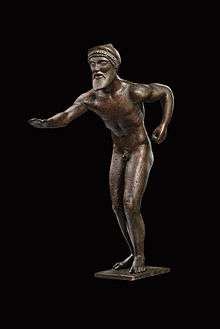Tübingen Hoplitodromos Runner
The Tübingen Hoplitodromos Runner (German: Tübinger Waffenläufer, i.e. literally: Tübingen weapons runner) is an antique statuette of a Greek athlete with a helmet made around 485 BC in Attica. It is exhibited in the museum of the University of Tübingen. At the end of the 19th century, the characteristic posture of the athlete led Friedrich Hauser to interpret the statuette as an armed hoplitodromos runner in the starting position, an interpretation that is undisputed today.[1]

Description
The small statuette is made from solid tin bronze. It represents a bearded naked man with a helmet in a forward leaning position making a small step with the left leg.[1] The athlete stands in the starting position typical for the Greeks, with the left leg stepping slightly forward and the right arm being stretched horizontally forward with open hand.[2] The hole in his left fist clearly indicates that he originally held an object.[1] Both feet stand on the ground, as if the runner is waiting for the sign to start the race, with his bearded face being raised expectantly. He bent his knees and tensed his inclined and well-muscled torso for the start. The chest is turned towards his left arm, on which he probably wore a round shield.[3] The statuette is missing its once separately worked shield.[2] The helmet bush is also lost by now, but ran originally forwards and backwards and initially hung down far to the back. By means of two round pins on the soles of the feet, the figure is firmly connected with its flat bronze base plate.[1]
The hoplitodromos was used for the physical training of the heavily armed warriors. At the same time, it was a combat tactic: Thus the united Greek army had initiated the decisive defeat of the Persians at the Battle of Marathon 490 BC with its attack on the run.[2]
History
A winner of a hoplitodromos competition might have commissioned the bronze figure around 485 BC and then donated it to the Acropolis of Athens.[2] The statuette might have been used as a votive by a victorious athlete in the sanctuary, where it was probably placed at a well visible location with an inscription, so that every passer-by was informed about the name and performance of the victorious athlete.[1]
Carl Sigmund Tux (1715-1798), a governmental officer, had inherited the statue from his father, and donated his collection to the University of Tübingen, when he died without heirs on 29 January 1798. The statue had initially an inconspicuous existence in Tübingen, until its value was recognised by the Munich court councilor Friedrich Thiersch. He recognized in 1827 the similarity of the 163 mm high bronze statue with the nearly life-size marble pedimental sculptures of the Temple of Aphaea on Aegina, which had arrived at that time in Munich, supplemented and reconstructed by the sculptor Bertel Thorvaldsen in Rome. It became thus apparent that the statue had to be supplemented with a shield.[1]
The statue was originally kept by the University Library of Tübingen, which moved to the castle in 1831. In 1833 it was given its own pedestal with a glass hood in the northeast tower of the castle. On the detour via various accommodations of the collection of classical antiquities in the Pfleghof and in Wilhelmstraße 9, the bronze statuette found its way back to the castle in 1997/98, to the same tower room that it had left over 100 years ago.[2]
As shown by x-rays, the statuette manufactured as a solid casting by the lost wax process. Three samples were taken in 1886 for a material analysis from the attached bottom plate and analyzed by the Tübingen chemist Lothar Mayer. The alloy is composed of 88 % copper, 11 % tin and 0.4 % iron. Only recently, modern techniques could also provide information about the material composition of the statuette itself: Investigations of the surface by means of spatially resolved μ-X-ray fluorescence and μ-X-ray diffractometry clearly show a slightly different alloy of the figure and the base plate and indicate that these have probably been assembled just in modern times.[1]
Weblinks
References
- Kathrin B. Zimmer: Schatz des Monats Januar: Der Waffenläufer ist ein altbekanntes Tübinger Highlight - Kleiner Athlet als Meisterwerk. Tagblatt, 5. January 2016.
- "Kulturgut". Retrieved 23 October 2011.
- Carol C. Mattusch: Greek Bronze Statuary: From the Beginnings Through the Fifth Century B.C. Cornell University Press, 1988, p.115.